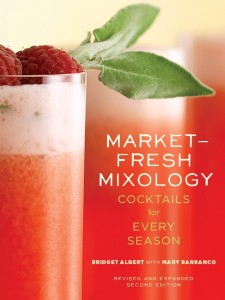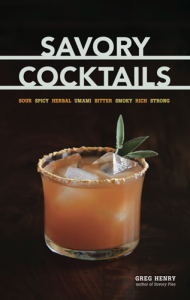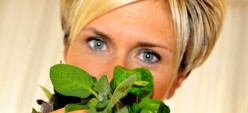Market-Inspired Cocktail Book Roundup
As we told you last week, it’s farmers market season as booths open around the city. And while you may be looking forward to snagging some vegetables for a spring risotto, we’d like to suggest you grab an extra bundle to make some cocktails.
Yep, we want you to add a little beet to your tequila or spruce up those kale smoothies with a good slug of botanical gin. And sprigs of fresh herbs? Garnish everything.
Home bartenders are squeezing fresh lemons and limes for their cocktails and buying quality-made spirits, but it’s time to step up the game. Seasonality and freshness know no bounds.
For inspiration, Chicago Foodies presents three of this year’s best books for putting a little spring in your sip. And make sure to check back tomorrow for an interview with author and bartender Bridget Albert and to find the recipe for one of her favorite spring cocktails!
Market-Fresh Mixology: Cocktails for Every Season, Bridget Albert with Mary Barranco
Market-Fresh Mixology (now in its second edition) is a great book for the casual mixer looking to spruce up their porch drinking. Far from intimidating, the recipes are simple to follow and anyone–regardless of experience–can pick up a copy and have cocktails by dinner. There’s no need for rare or expensive spirits or liqueurs, and the flavors of each season enter through easy-to-make simple syrups or juices.
That’s not to say that the ideas are simple, though. Those who know their way around the bar will still find plenty of inspiration. As the Cocktails for Every Season subtitle says, the book is divided into four sections – one for each time of the year. The first page of every group begins with a list of flavors to focus on and follows with dozens of recipes and gorgeous pictures. (Photography was done by James Bear award-winner Tim Turner.)
Whether you bring together fennel and añejo tequila for the spicy autumn “Refrescante” or start your spring off right with the carrot and ginger-laced “Carrot Chic,” this book has a use for your market bounty.
The days of sticky-sweet, artificial cocktails are gone. Long live savory!
Whether your love skews toward spicy and smoky or bitter and funky, there’s a drink that’s perfect for you in Savory Cocktails. Divided into categories like “umami”, “herbal” and “strong”, the more than 100 drink recipes draw on common market-inspired cocktail staples like cucumbers and herbs as well as more unusual mixers like tomatoes, chilies, and mushrooms. Some drinks are originals, but most are pulled from bar menus around the world and feature interesting back stories and explanations.
Like Market-Fresh Mixology, this book is full of eye-catching, beautifully photographed cocktails. The recipes are a little more challenging and might require a deeper liquor cabinet, but the results are stunning. Recipes for homemade syrups, shrubs and even bitters are presented, and the cocktails make frequent use of complex liqueurs, amari and even beers.
Sip decadent Truffle-infused Cognac, whip up refreshing lemon-dill meringue, or simply let the recipes stimulate your own creativity. Embrace bold flavors!
 The Drunken Botanist, Amy Stewart
The Drunken Botanist, Amy Stewart
Geeky science, playful histories, hand-drawn sketches, and encyclopedic breadth come together in The Drunken Botanist to deliver a surprisingly easy read.
This book is less a recipe collection (though plenty of cocktails are scattered throughout) as it is a reference. There are short entries on nearly every plant with a mixological application–be it distilled into a spirit, steeped to make a liqueur, or thrown into a cocktail as a garnish – that touch on biology, history and taste. Culture plays a big role for some–the sugarcane entry, for example, is weighty with a discussion of both the slave trade and the role of rum in the American Revolution–while others are just plain strange–cohineal scales, a type of insect that feeds off the prickly pear cactus, are crushed to make the vivid red dye which formerly colored Campari.
This is a book for all stripes — the gardener and the forager, the gin lover and the mezcal adventurer, or the homebrewer and the DIY infusion crafter.





Comments